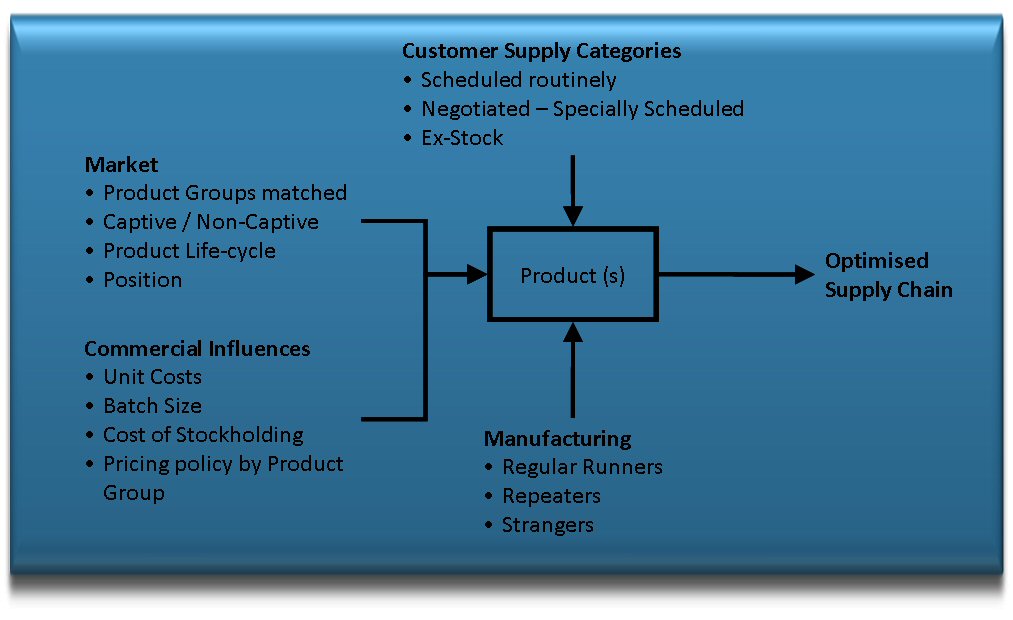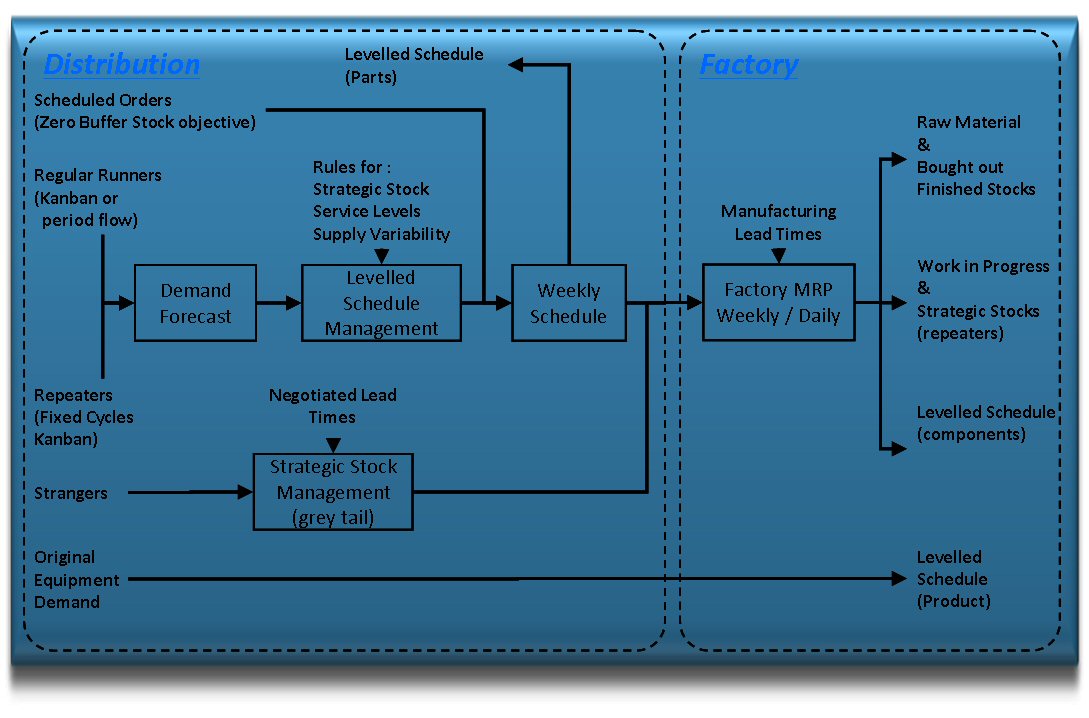5.10 - Supply Chain Improvement
Overview
The basis for a systems engineering approach to supply chain improvement is to start by flowcharting the process for each group of products. Calibrate the lead times between stages. Mark the stocking points and stock levels. Summarise ways to improve, including the removal of no-value added activities and separate stock control rules fore each group of components.
Availability on demand is viewed by the customer as the key service and provides opportunities for increasing sales revenue and competitiveness. Percent schedule achievement is an important measure of customer satisfaction.
Traditionally availability is achieved using expensive safety stock as a buffer against uncertainty in customer demand and supplier performance.
Reduce Stock Holdings and Maximise Availability
- Quick change flexibility is required to allow regular scheduled supply of small quantities not large batches.
- Carefully sized buffer stock may be needed at key points in the logistics chain using ABC type runner, repeater and stranger analysis.
- Very short lead times are essential for information flow between customer and supplier to avoid amplifying demand fluctuations
- A levelled scheduling operational practice must be installed along the supply chain to compensate for variations in mix of products demanded.
The stock level in a materials flow system is reduced if:-
- Lead time is reduced
- Batch size is reduced via quick process changeover in the factory and control of ordering sequence from the customer.
Natural Groups
Products should be structured into natural groupings (see guide 5.02) using input / output analysis techniques (see guide 4.03), to reflect the characteristics and influences of the distribution business.
This ensures that a common basis for scheduling and materials flow control is used at the factory interface and through the whole supply chain.

Two Examples of Matching of Natural Groups Across the Factory Interface are:-
Frequency of Supply |
Tend |
Service Level |
Market Requirement |
Runner |
Rising Star |
Ex-Stock |
Non-Captive |
Repeater |
Stable |
Scheduled |
Captive |
The criteria for establishing what parts should be in the appropriate categories for levelled scheduling will vary from business to business.
Different product groups are likely to have different requirements and the imposition of a single ‘standard’ form of control reduces competitive advantage. Some groups may require Kanban, others period control and others MRPII, which is the most complex.
|
|

|
Supply Interface - Manufacturing to Customer
|

|
|
- Strategic stocking points (lowest added value)
- JIT ordering / delivery + levelled schedules
- Improved supplier relationships
- Short process changeover times and lead times
- Set up scheduling meetings - weekly / monthly
|
|
- Joint approach to integration
- Optimise procedures and policies
- Characterisation of parts into natural groups and fit method of control needed for each group of runners, repeaters and Strangers.
- Finished goods have highest added value - minimise stocks
|
|
- Integrate customer ordering / stock management procedures
- Customer incentives to reduce batch sizes
- Define stock control rules for each category from Kanban to high-low reorder points
|
Integrated Supply Channel Strategy
It is important to use cross functional teams or committees to make levelled scheduling work, e.g. a monthly committee for rough-cut planning and weekly committee for accurate scheduling with representatives from manufacturing, sales and distribution. It helps to write standard disciplines and allow quality of performance auditing whilst ensuring responsibilities and roles are clear. Such committees must integrate the planning of all categories of demand from original equipment to service parts.
Look ahead forecasting procedures are required for each product group.
The Three Levels of Sales Demand Forecasting and Scheduling
Level |
Description |
Actions |
1 |
Strategic |
Business unit forecast of market trends over 6, 12, and 18 month horizons |
2 |
Procurement |
Monthly and 3 monthly forecast by part number to determine purchased materials required (Master Production Schedule [MPS]) |
3 |
Manufacturing Cell |
Weekly levelled-to-capacity schedule including maintenance time allowances. The bottleneck process is found and work is planned in the optimum sequence for it. Kanban cards, including accumulators to minimise changeovers should also match this sequence. |
Scheduling and Stock Management Interface

Levelled Scheduling - The Service Demand
Objectives |
- To remove supply variability and provide constant levels of demand by allowing stock to fluctuate
|
Method |
- Choose products / parts which are required and manufactured regularly at volumes greater than the minimum manufacturing batch size. Aim for smallest batch sizes.
|
Levelled scheduling can take place in: |
Distribution Warehouse |
|
Business Unit |
- At product level, interleaving all elements of mixed demand into a monthly capacity total
|
Manufacturing Cell |
- At key component level for each manufacturing cells “bottleneck” process.
|
The key features are:
- The supply is responsible for coping with variability in demand by establishing buffer-stocks and levelled scheduling of mix within a fixed capacity of process hours
- Buffer stock is designed ONLY for variability in DEMAND - NOT for variability in
SUPPLY
Setting the Levelled Schedule
Combine forecast mix demand with stock target to cover replenishment lead time with an additional safety stock to provide agreed customer service level. Fit the schedule with optimised changeover times to suit capacity of the bottleneck process in each cell.
Changing the Levelled Schedule
Consider change in mix when stock levels fall outside upper or lower limits set around to stock mix targets. Produce exception reports for consideration by appropriate planning committees.